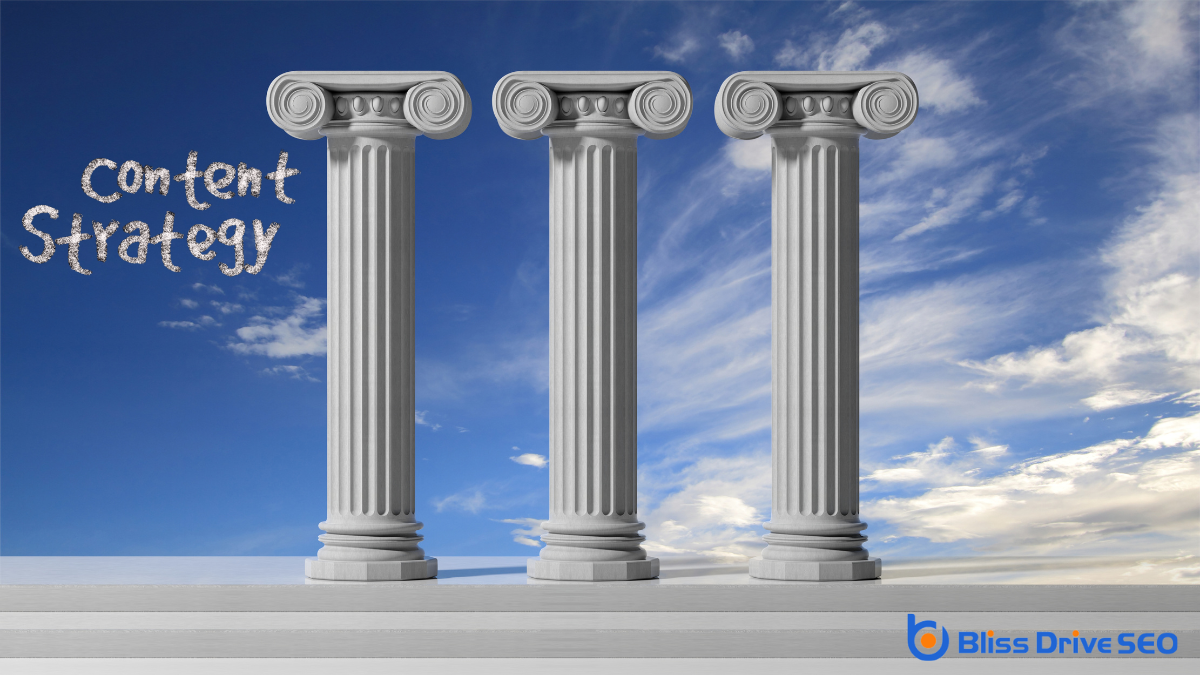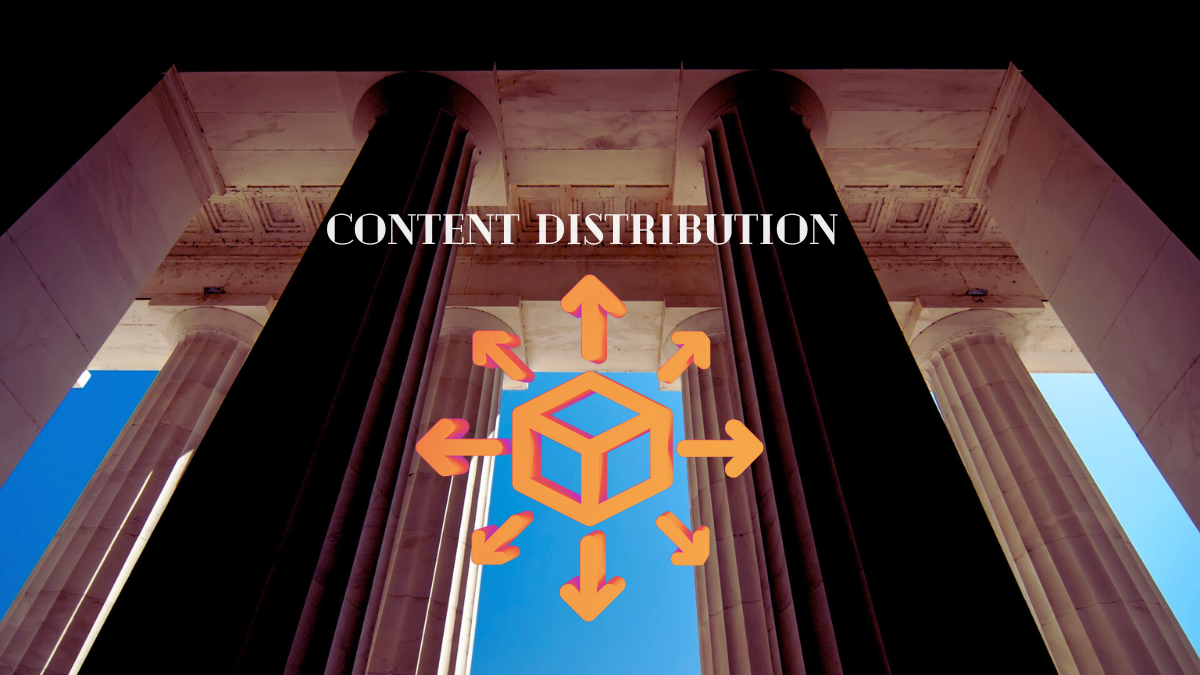Digital Marketing Services
Learn More About Us

The three pillars of content strategy—content creation, distribution, and management—are essential for achieving business goals. Start by crafting content that's thoughtfully aligned with your audience's needs and preferences to engage and solve their problems. Next, ensure your content reaches the right people by distributing it across channels where your audience spends their time. Finally, manage your content effectively with clear organization and regular performance assessments to keep your strategy on track and responsive to changes. These pillars interconnect to form a robust strategy that enhances your brand's impact and engagementThe interactions that users have with a brand’s content on social media.. Let's explore how they can transform your content approach.
Content strategy is an essential framework that guides how you create, deliver, and manage content to meet your business goals. It's not just about creating content for the sake of it; it's about ensuring every piece serves a purpose. You need to ask yourself: What do you want your audience to learn, feel, or do after engaging with your content? This clarity helps in crafting messages that resonate and drive action.
To truly understand content strategy, think about it as a roadmap. It outlines what content is necessary, when and where it should appear, and how it aligns with your audience's needs.
You'll need to take into account your audience's preferences and behaviors, which means doing your homework on who they're and what they care about.
Your strategy should also consider different content types. Whether it's blog posts, videos, or social media updates, each has its role in engaging your audience.
Consistency is vital; your content should reflect your brand's voice and values across all platforms. By understanding these elements, you're better equipped to create content that not only attracts but also retains your audience's attention.

A well-crafted content strategy is crucial for ensuring your messaging doesn't just fill space but actively drives your business objectives. It's not enough to simply churn out content; you need a plan that aligns with your goals.
When you develop strategic content, you're aligning your communication with what your audience truly needs and values. This alignment guarantees your messages resonate, engage, and convert.
Strategic content acts as a bridge between your brand and your audience. It helps build trust by consistently delivering value and addressing the pain points of your target market.
When your content is purposeful and relevant, your audience is more likely to see you as an authority in your industry. This perception can leadA potential customer referred by an affiliate who has shown interest in the product or service but h... to increased brand loyaltyThe tendency of consumers to continue buying the same brand's products or services. and word-of-mouth promotion.
Moreover, strategic content can improve your search engine visibility. By focusing on topics that interest your audience and incorporating relevant keywordsWords or phrases that users type into search engines to find information. naturally, you increase the chances of your content being discovered.
This not only attracts more visitors to your site but also keeps them engaged longer. Essentially, without strategic content, you risk wasting resources and missing opportunities to connect meaningfully with your audience.
Every successful content strategy begins with thoughtful content creation. At its core, content creation involves generating valuable information that resonates with your audience. You need to understand who your audience is and what they care about. This means researching their interests, pain points, and the questions they're asking. Once you grasp this, you can craft content that speaks directly to them.
Start by identifying key themes and topics that align with your brand's goals. Consider the formats that will best engage your audience, whether it's blog posts, videos, podcastsAudio content distributed through digital channels, often in series format., or infographicsVisual representations of information, data, or knowledge intended to present complex information qu.... Each piece of content should serve a purpose, whether it's to inform, entertain, or solve a problem.
Organize your content ideas in a structured plan. A content calendarA schedule for planning, creating, and publishing content. can help you schedule and track these ideas, ensuring consistent delivery.
Don't forget to align your content with your broader marketing goals, ensuring every piece contributes to your strategy.
To improve your content quality, start by prioritizing relevance to guarantee it meets your audience's needs and interests.
It's essential to maintain a consistent voice so your brand feels cohesive and trustworthy.
Focus on these elements to keep your content engaging and aligned with your strategic goals.
In the domain of content strategy, ensuring relevance is vital to improving quality. To make your content resonate with your audience, you've got to understand their needs, interests, and challenges.
Start by researching your target audience. Identify their pain points and what they're searching for. This knowledge allows you to tailor your content to address their specific concerns, making it more valuable and engaging for them.
Next, align your content with current trends and industry developments. Staying updated helps you provide timely information that your audience finds useful. Use tools like Google TrendsA tool to analyze the popularity of search queries over time. or social media analyticsThe process of gathering and analyzing data from social media platforms to inform business decisions... to see what's trending and incorporate those insights into your content planning.
Also, don't forget to analyze the performance of your existing content. Review metrics such as page views, time on page, and bounce rates to determine which pieces are resonating and which aren't. Use this data to refine your strategy, focusing on topics and formats that have proven effective.
Lastly, maintain a feedback loop with your audience. Encourage comments, questions, and suggestions. Engaging with your readers not only builds trust but also gives you direct insights into what they find relevant, helping you continuously enhance content quality.
A consistent voice is the backbone of a strong content strategy. It creates a recognizable identity, helping your audience connect with your brand on a personal level. When you maintain a consistent voice, your content feels familiar, trustworthy, and reliable, no matter the platform or format. This familiarity builds trust, encouraging your audience to engage with your content more frequently.
To maintain a consistent voice, start by defining your brand's personality. Is it formal, friendly, authoritative, or playful? This decision will guide the tone and language you use across all your content. Document these guidelines clearly and share them with everyone involved in content creation. This guarantees everyone is on the same page and can contribute to maintaining a unified voice.
Consistency doesn't mean rigidity. Adapt your voice to suit different contexts while staying true to your brand's core identity. For instance, a social media post might be more casual than a press release, but both should reflect your brand's essence.
Regular reviews and feedback sessions can help you stay aligned with your voice guidelines, ensuring your content remains engaging and effective. Remember, a strong and consistent voice can set you apart from the competition.

Effective content distribution is critical in ensuring your carefully crafted content reaches the right audience. You can't just create great content and hope it finds its way to your target audience. You need a strategy that actively places your content where your audience is most likely to see it.
Start by identifying the platforms your audience frequents, such as social media, email newsletters, or industry-specific websites.
Once you've pinpointed these platforms, tailor your distribution methods accordingly. For instance, if your audience engages most on LinkedInA professional networking site used for career and business networking., focus on sharing articles and updates there. You might opt for InstagramA photo and video-sharing social networking service owned by Facebook. if your content is visually driven. Each platform has its own set of best practices, so adjust your approach to match.
Consistency is key. Regularly post your content to maintain visibility. Don't just push content; engage with your audience. Respond to comments and participate in discussions to build a strong community around your brand.
To optimize your distribution channels, start by understanding your target audience's preferences and behaviors.
Tailor your approach with platform-specific tactics that resonate with where your audience spends their time.
Understanding your target audience is vital when optimizing distribution channels in content strategy. By knowing who your audience is, you can tailor your approach to meet their preferences and habits. Start by gathering data on demographics, interests, and behaviors. Use tools like surveys, social media insights, and website analyticsThe systematic computational analysis of data or statistics to gain insights and support decision-ma... to gain a thorough view.
Once you've collected this data, analyze it to identify patterns. Look for common characteristics and preferences in how your audience consumes content. Are they more likely to engage with video content on social media, or do they prefer reading blog posts?
Do they spend more time on mobile devices, or are they desktop users?
With this information, you can choose the most efficient distribution channels. If your target audience is active on a specific platform, focus your efforts there. Customize your content format and style to fit the platform and the audience's preferences.
Regularly revisiting your audience analysis is vital. As trends and technologies evolve, so will your audience's habits. Staying updated ensures your content remains relevant and engaging, maximizing its impact. In this way, understanding your target audience directly influences the success of your content distribution strategy.
One of the essential steps in optimizing distribution channels is to adopt platform-specific tactics tailored to your audience's preferences. Each platform has its unique characteristics and user behaviors, so you need to adjust your content to fit.
For example, FacebookA social networking site where users can post comments, share photographs, and links to news or othe... favors engaging visuals and community interaction, while LinkedIn thrives on professional insights and industry news. Understanding these nuances helps you create content that resonates better with your audience.
To maximize, start by analyzing which platforms your audience uses most frequently. Are they more active on Instagram or TwitterA microblogging and social networking service where users post and interact with messages known as "...? This knowledge directs your focus and efforts.
Then, consider the type of content that performs well on each platform. Twitter, with its character limit, demands concise, impactful messages, whereas YouTube allows for in-depth videos.
Don't overlook timing, either. Posting when your audience is most active increases visibility and engagement. Use analytics toolsSoftware used to track and analyze website performance, user behavior, and marketing efforts. to track performance and adjust strategies.
Experiment with different formats, such as live videos or polls, to see what gets the best response. By aligning your content strategy with each platform's strengths, you secure your message reaches and resonates with the right people, maximizing your impact and engagement.
Managing content effectively requires a strategic approach that guarantees your content is organized, accessible, and aligned with your overall objectives. You need to think about the tools and systems that can help streamline this process. Content management systems (CMS) are essential, as they allow you to store, edit, and publish content with ease. Choose a CMS that fits your needs, whether it's WordPress, Drupal, or a custom-built solution.
Next, focus on categorizing your content. Use tags and categories to keep everything tidy and easy to find. This not only helps you but also makes it easier for your audience to navigate your content.
Develop a clear content calendar, outlining when and where your content will be published. This keeps you on track and guarantees consistent delivery.
Don't forget about version control. You'll want to track changes and maintain backups to avoid losing valuable content. Collaborate with your team using shared documents and regular check-ins to stay aligned. By implementing these practices, you'll create a smooth workflow that supports your content strategy and helps you focus on creating high-quality content that resonates with your audience.

To truly gauge the impact of your content strategy, you must establish clear metrics that align with your business goals. Without these benchmarks, you'll struggle to determine if your content truly resonates with your audience or meets your objectives. Start by identifying key performance indicators (KPIs) that reflect success for your brand—whether it's increased website traffic, higher engagement rates, or more leads generated.
Once you've defined your KPIs, use analytics tools to track your content's performance. These tools can monitor various aspects, such as page views, time on site, bounce rates, and conversion rates. By regularly reviewing these metrics, you can identify trends and adjust your strategy accordingly.
Don't just look at surface-level data; dig deeper to understand the reasons behind your successes and areas needing improvement.
It's also essential to gather feedback from your audience. Surveys, comments, and direct interactions can provide valuable insights into what your audience values. Use this feedback to refine your messaging and content formats.
In crafting a successful content strategy, you focus on three essential pillars: creation, distribution, and management. By honing your content creation skills, you guarantee top-notch, engaging material. Through strategic distribution, you maximize your reach across best-fit channels. Finally, with effective content management, you measure success and adapt to ever-evolving needs. By mastering these pillars, you're not just creating content—you're building a foundation for ongoing growth and connection with your audience.
